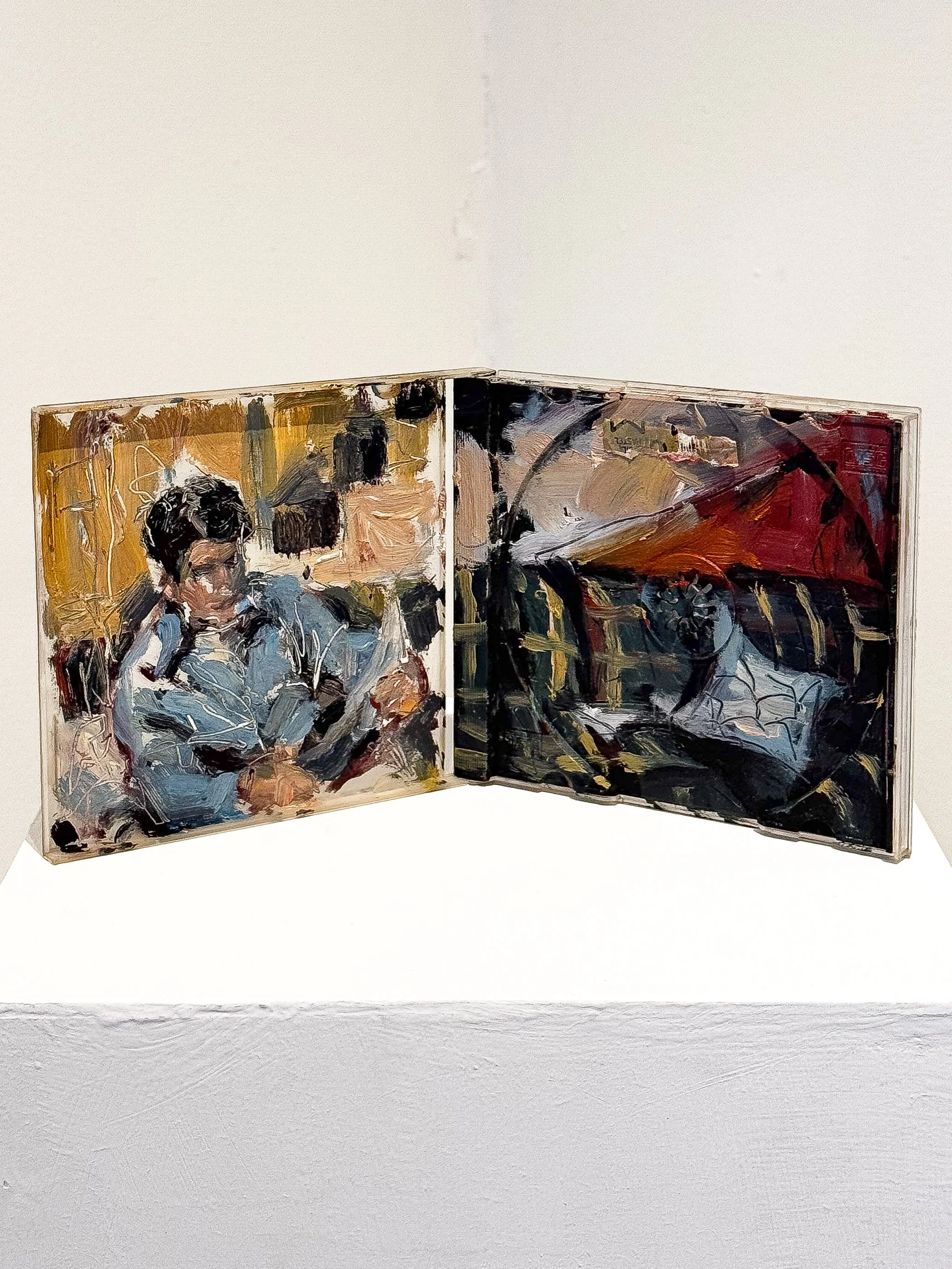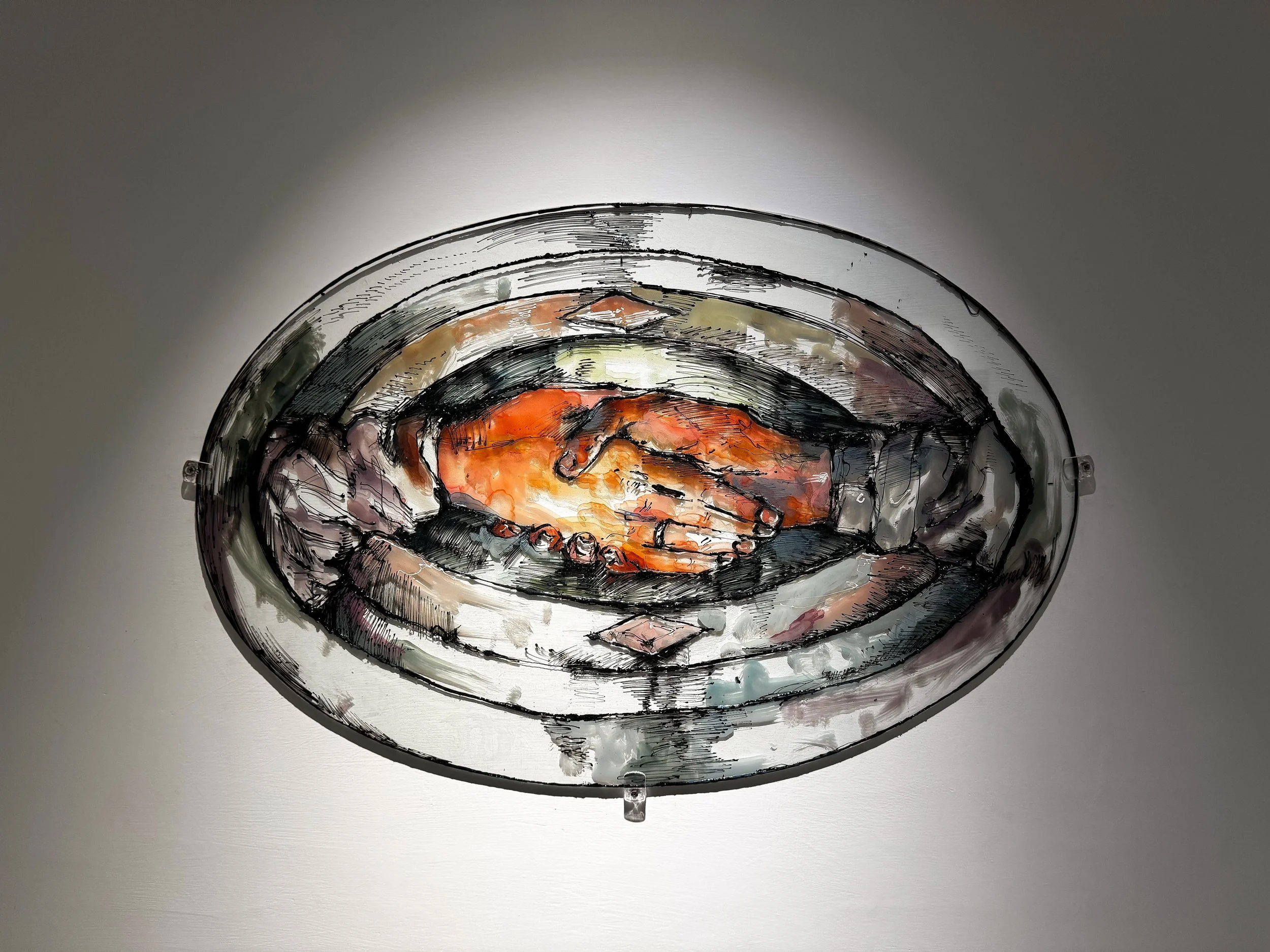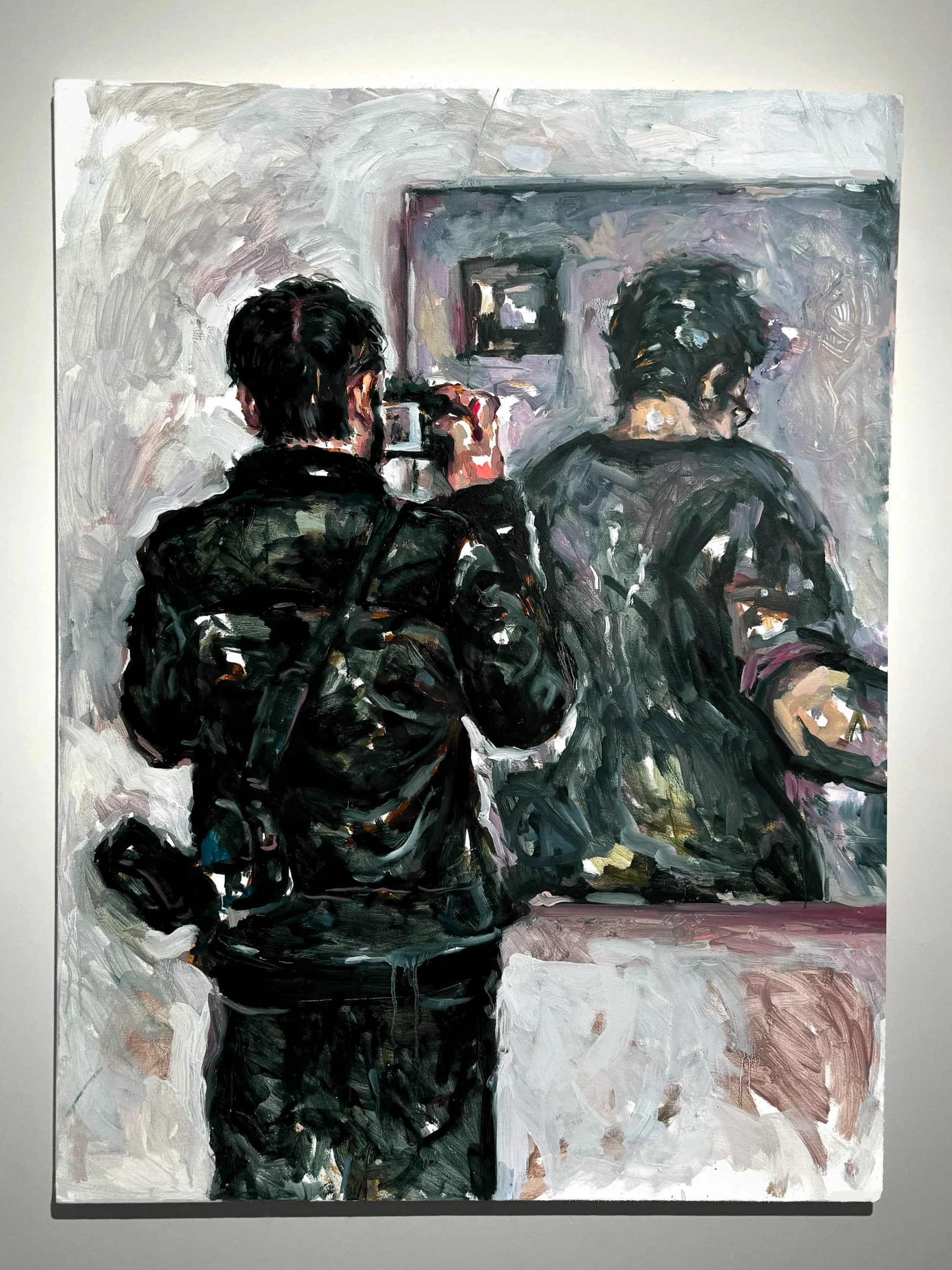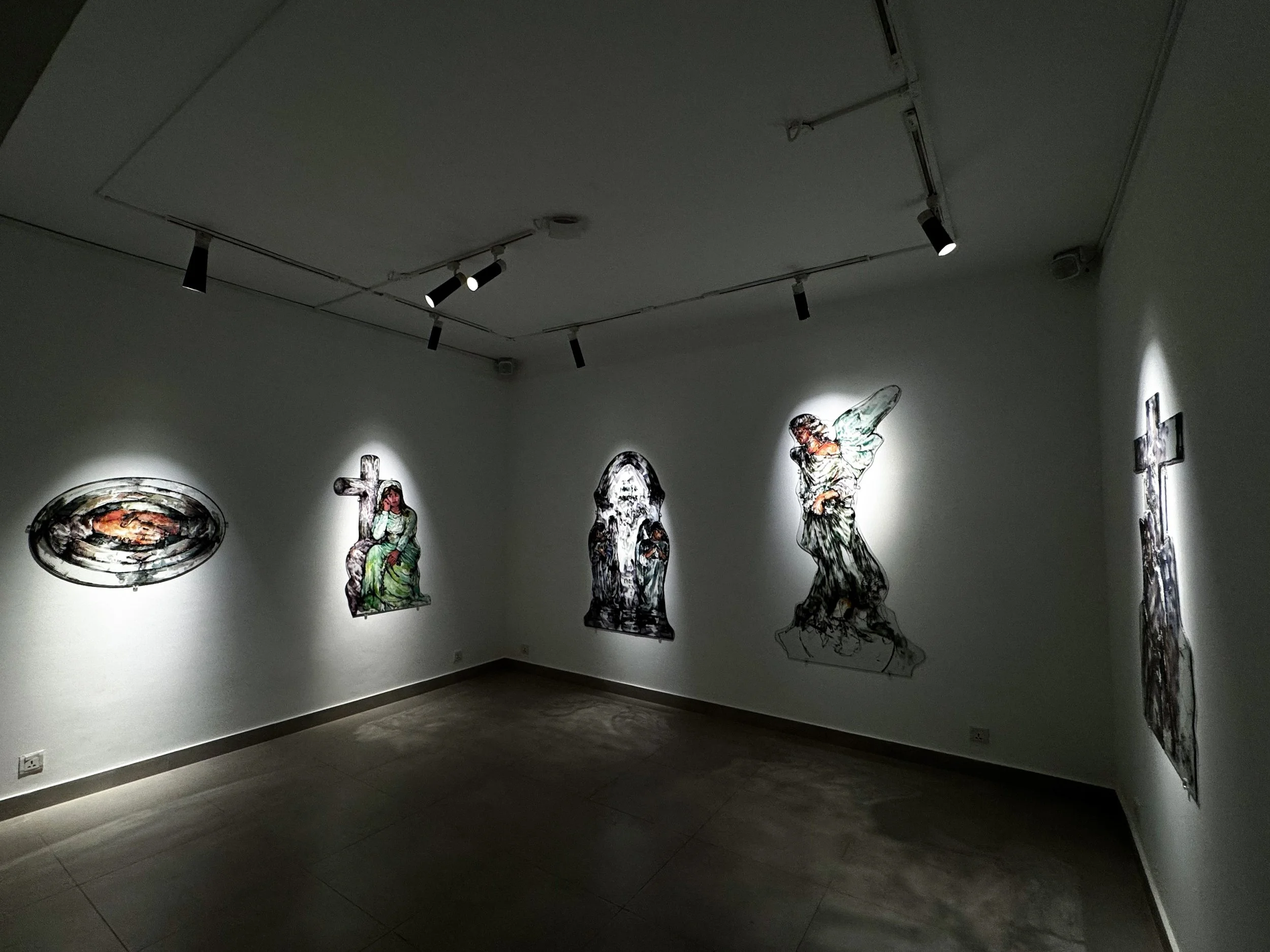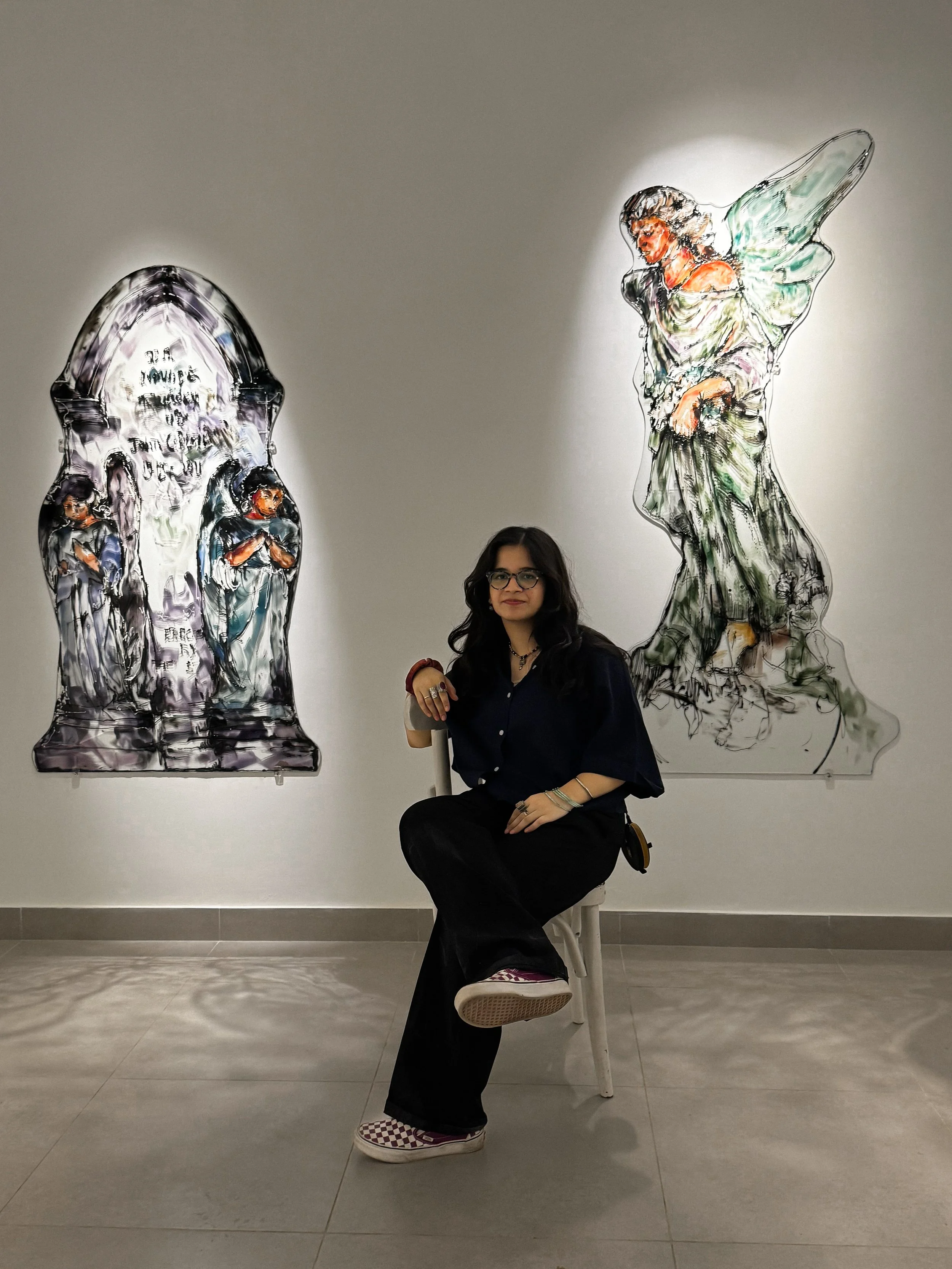DRAWING THE FORGOTTEN WITH VANIA MAZHAR
Lahore-based artist Vania Mazhar is part of a new generation of Pakistani painters expanding the language of their medium into experimental forms. With a practice that moves fluidly between painting, installation, video and sculpture, she builds immersive environments that respond to sites, memory and overlooked traces of history. Alongside exhibiting in museums and galleries across Pakistan, Mazhar teaches drawing at the National College of Arts, grounding her explorations in the daily rhythm of mark-making.
Her art takes root in overlooked spaces - graveyards, neglected religious sites, fragile urban traces, where memory and grief intersect with acts of erasure. Starting with the intimacy of her sketchbook, Mazhar’s practice evolves into larger canvases, assemblages and projection-based installations that weave together brushwork, found objects, sound and moving image. With a growing exhibition record that includes the COMO Museum of Art, Canvas Gallery, Zahoor ul Akhlaq Gallery and Vasl Artists’ Association, as well as collaborations supported by the British Council and Glasgow Museums, she is steadily gaining recognition within Pakistan’s contemporary art scene and beyond.
Her participation in the Our Shared Cultural Heritage project (2023) between Glasgow and Lahore marked a pivotal moment, introducing digital collaboration to her work and setting the stage for future residencies, such as her time at Vasl in Karachi in April 2025. In these exchanges, Mazhar discovered new ways to integrate collective processes into her practice while remaining anchored to her sketchbook, the starting point of every mark she makes.
What follows is a conversation with Mazhar, where she reflects on her process, collaborations and ambitions as an artist whose work continuously seeks to hold space for memory, loss and repair.
How would you describe the art that you create?
The art I create always begins with drawing. Whether I am painting on canvas, building a projection-based installation, or shaping a layered sculpture, it starts with a line or a mark, much like the ones that fill my sketchbook that never leaves my bag. My practice expands into installation, sculpture and video, where found objects, glass, sound and image interweave.
I am drawn to overlooked spaces and fragile histories, including graveyards and through my work I seek to document, preserve and re-imagine what is often forgotten, silenced or erased. My art is tactile and research-led, shifting between mediums to create environments that hold memory, grief and marginality while also opening space for repair and continuity.
What are the main messages that the art you create communicates?
I want my work to bring attention to what is usually overlooked. For me, that often means places like graveyards or fragile sites that hold memory and history but are slowly fading from view. Through my art I try to speak about absence, loss and erasure, but also about the possibility of care and repair. By engaging with neglected spaces such as graveyards and fragile sites of history, I try to highlight how loss and erasure shape both personal and collective experience. At the same time, my art is a way of documenting the places I visit and the people I meet. It often begins with my sketchbook, where I draw everything around me, and then extends into a larger practice of recording and highlighting the more pressing concerns I see in society.
How would you describe the emotions that your art aims the observer to feel?
I do not want to control what someone feels when they encounter my work. Instead, I hope to guide them toward reflecting and observing, to notice what might be present in the silences, absences or details of the work. I would like them to experience the work with me, whether through the materiality of my brush marks or the immersive quality of the video installations I create. My art is less about telling the viewer what to feel and more about opening a space where their own thoughts and emotions can surface.
In terms of creative collaboration, how do you see the idea of bringing someone else’s vision together with your artistic talent - what outcome could that create?
Collaboration first became meaningful for me during the Our Shared Cultural Heritage project between Glasgow and Lahore. I worked digitally with the Glaswegian cohort to create works that connected the two cities, and under the guidance of Maliha Noorani, who led the project, I realized how collaboration can open up new ways of thinking and making. This experience shaped how I approached my time at the Vasl Artists’ Association residency in Karachi in April 2025, where living and working alongside other artists made collaboration feel like a natural extension of my practice. I began documenting them through drawing and painting, which encouraged me to exchange ideas more freely and allow their perspectives to influence my own. For me, bringing someone else’s vision together with my own creates outcomes that are richer, more layered and filled with possibilities I could not reach alone.
“My art is about opening a space where the viewer’s own thoughts and emotions can surface.”
Which part of your creative process do you enjoy the most?
I enjoy drawing in my sketchbook the most. I usually begin my week in the studio by sketching and from there I move into painting. I love the stage of painting where everything slowly comes together through layers of paint and brushwork. Teaching is also part of this rhythm, since I teach drawing and often use that time to sketch alongside my students and observe the act of drawing itself. For me, the sketchbook, the canvas and the classroom are all spaces of discovery where I can keep exploring and reflecting.
What is the first creative moment that you remember? Does it have a connection to the art that you create now?
One of my earliest creative memories is sitting in my grandfather’s office in my hometown, waiting with my mother to go home. She picked up a pencil and a scrap of paper and began sketching a landscape. I remember being amazed at how she could create something so full with such simple means. My grandfather later put that drawing up on the wall, and I often found myself staring at it, wishing I could draw like that someday. Looking back, I see how much that moment shaped me. Drawing with nothing more than a pencil and paper is still at the heart of my practice today.
Do you have any creative rituals that you always follow when creating? If yes, what are they and what do they give to your creative process?
Yes, I do. I usually begin by making myself an espresso and sitting with it in the studio while sketching the next painting in my old sketchbook with a pencil. It is a way of easing myself into the day. I also set up my space according to the scale of the work I am about to make and I like to start slowly with my favorite playlist in the background (which includes Big Thief and David Bowie these days). I keep books on my favorite artists nearby and when I feel out of energy or stuck, I flip through the images to remind myself why I create. These small rituals keep me grounded, recharge me when I need it, and help me slip into the rhythm of painting and creating art that I deeply love.
What is success and what is failure in your work?
For me, success is when my heart is at ease with what I make. It is when I can translate how I feel about my subject into the work in a way that makes me content. Success is also when the work opens a space for others to pause, reflect or see something differently.
A failure, on the other hand, is when I do not resonate with what I have made, when it feels forced to be perfect under the usual umbrella of strictly only gallery-ready art. That, to me, is the biggest failure in painting and art. Even so, I see failure as part of an artist’s practice, because it reminds us to return to what feels honest and meaningful.
“I keep books on my favorite artists nearby and when I feel out of energy or stuck, I flip through the images to remind myself why I create.”
What is your greatest ambition with the work that you do?
My greatest ambition is to make work that quietly shifts how people notice and care for the overlooked. I want my art to open up conversations about memory, loss, and repair so that neglected places and fragile histories are seen and held with more attention and care. On a personal level I wish to paint better every single day, to make art that is stronger and more honest than the last painting or work I created. My biggest ambition is to keep creating and to keep learning, because the act of making itself is what helps me grow.
Practically, I hope to build a body of work and research that can travel beyond my studio through exhibitions, public projects, residencies and publications so these stories and sites can reach new audiences. I also want to keep teaching and working with others, because exchange and collaboration have consistently expanded my thinking and practice.
Follow Vania’s work on Instagram at @mintvader and stay tuned for future features of Creative Intersect at @thecreativeintersect.




